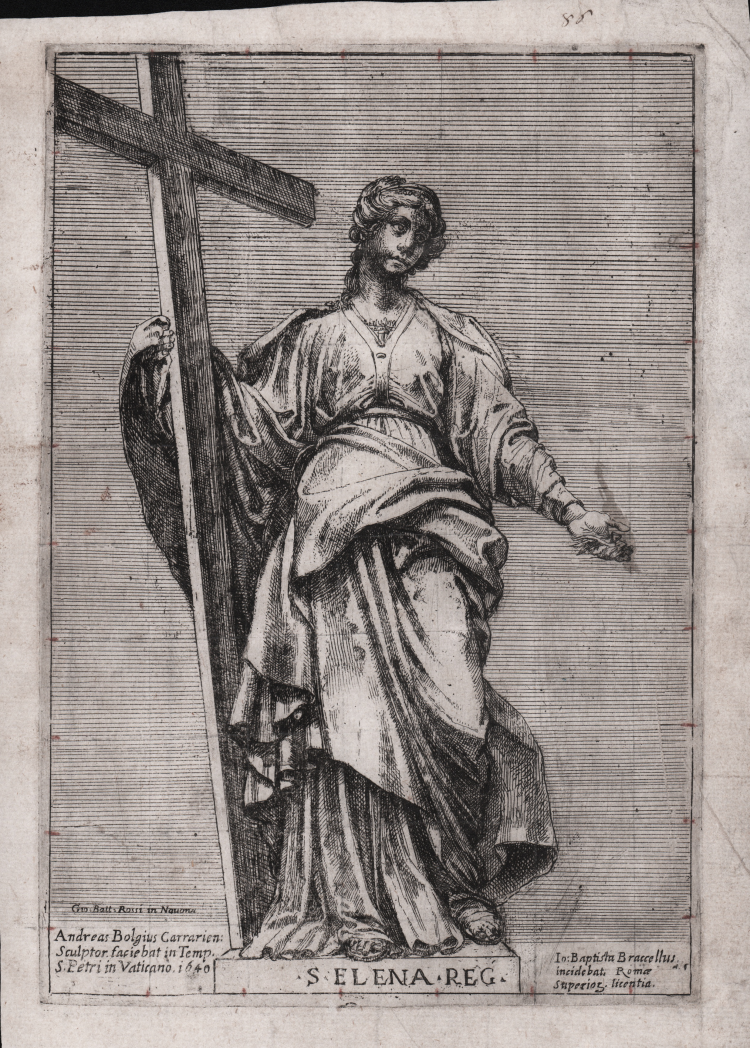



| Reference: | S43534 |
| Author | Giovanni Battista Bracelli |
| Year: | 1640 |
| Measures: | 185 x 265 mm |


| Reference: | S43534 |
| Author | Giovanni Battista Bracelli |
| Year: | 1640 |
| Measures: | 185 x 265 mm |
Etching, 1640, after Andrea Bolgi.
Titled in lower margin 'S Elena Reg', with production details: 'Andreas Bolgius Carrarien sculptor faciebat in Temp S Petri in Vaticano 1640' and 'Io Baptista Braccellus Flor incidebat Romae superior licentia' and with address 'Gio Batt Rossi in Navona' within the image.
From a set of the four monumental sculptures in the crossing of St Peter's in Rome. The complete group was first illustrated by Katharina Mayer Haunton in 'Print Quarterly' XV 1998, from a set sold Sotheby's, London, 1 December 1988, lot 6.
“The etchings of Giovanni Battista Bracelli and Remigio Cantagallina are not common, so it seems worthwhile to record and reproduce two apparently undescribed sets which appeared at auction in London (Sotheby's, 1 December 1988, lots 6 and 15). The first is a set of four prints by Bracelli (figs. 161 a-d) based on the outsize statues in the crossing niches of the Basilica of St Peter's in Rome: St Andrew by Francois Du Quesnoy, St Longinus by Gianlorenzo Bernini, St Helena by Andrea Bolgi and St Veronica by Francesco Mochi. The etchings represent very important pieces of sculpture and were published by Giovanni Battista Rossi in 1640. Rossi normally printed quite large editions of the etchings he published, but nevertheless these appear to be rare and unrecorded. The biting of the plates is uneven and they may have broken down during printing. Since there are four statues, the set is likely to be complete unless it once had a titlepage. However, in the article on Bracelli in Thieme-Becker two other etchings by him after sculpture in St Peter's are listed - one of Bernini's Baldacchino and the second of Algardi's relief Attila in Rome (dated 1649). It is possible that they were intended to form part of a series of etchings of sculpture in the Basilica started in 1640 but still not complete in 1649” (cf. Mayer Haunton, Bracelli and Cantagallina Addenda, in 'Print Quarterly' XV 1998, p. 298).
The artist, who proclaimed himself a Florentine painter on the title page of this series, can probably be identified with "Giovanbatista called it Bigio," a student of Jacopo da Empoli who painted the allegorical figure of Honor on the ceiling of the Casa Buonarotti in Florence in 1616-1617, graduated from the Accademia del Disegno in 1619, and worked with his master on the ceiling of the cathedral in Livorno before its completion in 1620. Because Bracelli's paintings are virtually unknown, few drawings can be identified as his.
His life and work are best reconstructed in conjunction with his eighty-eight etched plates dated between 1624 and 1649. From Livorno in 1624 came the fifty plates of the Bizzarie, Bracelli's most original effort. A series of thirty-one small plates, depicting pairs of musicians and entitled Figure con instrumenti musicali e boscarecci (Figures with instruments musical and sylvan), was issued in Rome, probably between 1625 and 1630. In these, the figure style recalls Bracelli's Florentine training and is reminiscent of Tempesta's style as well. The artist was in Rome by 1626, when he issued an etching of Bernini's Baldacchino in Saint Peter's. In 1640 Bracelli made four etchings that represent the monumental figure sculptures by Bernini and others at the crossing of that basilica. Bracelli's last dated print (1649) reproduced Algardi's sculpture of Attila. A Roman procession (1629) after a drawing by the Florentine painter Agostino Ciampelli and an undated Bacchanal complete Bracelli's works, except for his inventive Alfabeto Figurato (Figured Alphabet), published in Naples in 1632, in which the letters are composed of nude figures. Whereas the subjects of Bracelli's Roman prints show that he was attentive to new, fully Baroque works of art, his etching technique was crude and his drawing style heavy-handed. He was at his best in his depiction of musicians and above all in the Bizzarie, where he revealed a debt to the more Mannerist art of Jacques Callot and where the powers of his imagination rose above the level of his relatively mediocre drawing abilities.
A fine impression, printed with tone on contemporary laid paper, with margins, very good condition.
A very rare work.
Bibliografia
Katharina Mayer Haunton, Bracelli and Cantagallina Addenda, in 'Print Quarterly' XV 1998, pp. 298-302; S. Welsh Reed, Giovan Battista Bracelli, in “Italian Etchers of the Renaissance & Barocque” (1989), pp. 230-233.
Giovanni Battista Bracelli(attivo in Toscana nel primo quarto del XVII seolo)
Giovanni Battista Bracelli(attivo in Toscana nel primo quarto del XVII seolo)